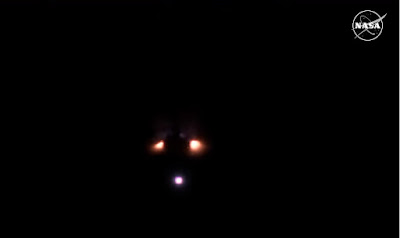. . . The weekly virtual “gratitude jar.”
This week, I’m expressing thanks for NASA’s Artemis I.
“We are going back to the moon.” Did you watch the launch of Artemis I Wednesday morning? It was worth getting up early to see! If you missed it, you can see the official NASA broadcast on YouTube here. And here’s a link to NASA’s Artemis I web page.
All the pictures of this post are screenshots from the YouTube video, or else they are photos of that video playing on my computer monitor. Because sometimes you want to remember what it was like, personally, to participate in this event.
This Space Launch System (SLS) and spacecraft (Orion) are designed to get people to the Moon and back, and eventually allow people to travel from the Moon to Mars. The Artemis I mission is un-crewed, operated by programming and remote transmissions, as they’re testing the system before sending living people up in it. It’s also multitasking with several other experiments and stuff.
The biggest deal on Wednesday was the SLS—the massive rocket system that launched the capsule out of Earth’s atmosphere and into space, heading toward the Moon and beyond.
The launch system is simply fantastic. The liftoff was intensely dramatic—like watching a volcano erupt, but on cue and perfectly in control: “Three, two, one, boosters and ignition . . . And liftoff of Artemis I! We rise together—back to the Moon, and beyond!”
After about 1 minute after liftoff, the rocket was going over 600 mph, with 8 million pounds of maximum thrust. About 20 seconds later, it was 1,420 mph. Just 2 minutes and 11 seconds after liftoff, the two solid rocket boosters had done their job and were jettisoned. Soon after that, the rocket was traveling at more than 3,400 mph.
Three minutes into the launch, the speed was 4,060 mph; after another minute, it was up to 5,200 mph. At 5 minutes, the speed had increased to more than 6,800 mph, and a minute later to 8,800 mph. At T+06:20, the speed had exceeded 10,000 mph, and at T+07:00 it was up to 12,000.
Then, after 8 minutes of flight, the main rocket engine cutoff occurred, and the core stage separated from the Orion capsule, which was then considered to be in Earth’s orbit. After that, in following days, it would continue on to the Moon. At the point of main engine cutoff, the speed was more than 16,000 mph.

Do you know how orbiting works? Think about it this way. If you hold a ball in the air and then let it drop, it falls straight down to the earth, thanks to gravity. If you flip the rock sideways a little, it still falls to earth, but it follows a curved path. If you throw or pitch the rock a little harder and faster, the rock travels farther, and its curved path is wider. If you shot the rock out of a cannon, it would travel even farther, tracing an even wider curve, before falling to earth. But what if you shot the rock so fast and far that its curved, falling path actually matches the curvature of the planet? It would continually be falling . . . but it would never fall to earth.
By the way, the current land speed record is 760 mph. The air speed record (by ducted jet engine aircraft, within the atmosphere) is something like 2,193 mph, set by a Lockheed SR-71 “Blackbird” Mach 3+ jet.
The Orion spacecraft, with its 26-day mission, will eventually take a far-distance elliptical orbit around the moon, traveling a maximum of 280,000 miles away from Earth and 40,000 miles beyond the far side of the moon. That’s substantially farther than the 1970 Apollo 13 mission, during which the astronauts traveled a maximum of 248,655 miles away from Earth.
This is a big deal, you all! Yes, we’ve sent amazing remote-controlled equipment into space, to Mars, to Jupiter, and beyond. . . . And as for crewed space flights, the various space shuttles and space stations have all remained in low Earth orbit. No humans have truly gone out into space since the Apollo 17 mission in 1972.
Exploring is what humans do. Learning, identifying, describing, making connections, questioning, making predictions, testing, understanding, recording, and communicating about it . . . that’s what humans do. That is our superpower. It’s our ministry. It’s in our DNA.
We are the portion of the Earth that is programmed and equipped to allow Earth to see and try to understand itself. We animals are its eyes, brains, and conscience.
And are you excited that NASA is pointing out, strongly, that the Artemis missions will land the first woman and the first person of color on the moon? You should be. It’s an indication that we’re not stuck in the 1950s, even though some people seem to think that’s where we should return. So including all types of our nation’s people in the space program is a strong signal that everyone in our country is encouraged to contribute—because diversity is our nation’s strength. And we need to get back to that thinking!
. . . So that we can rise together!





















































